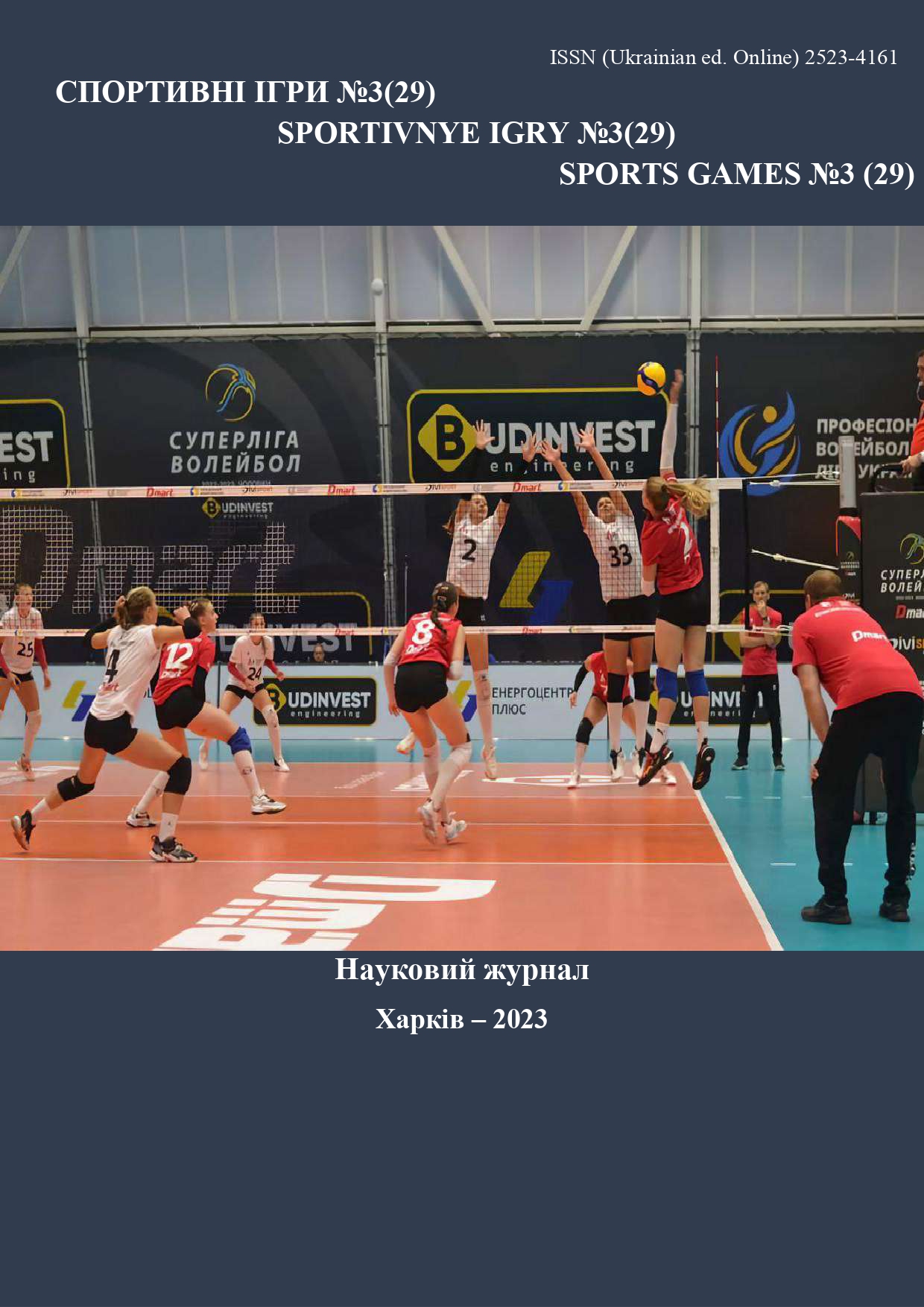Correlation of the level of physical fitness with morphofunctional indices of qualified players in rygby-7
DOI:
https://doi.org/10.15391/si.2023-3.04Keywords:
rugby-7, correlation, physical fitness, morphofunctional indicesAbstract
Aim: to define interrelation of the level of physical fitness with morphofunctional indices of qualified rugby players in rugby-7. Materials and methods of research. The following commonly applied methods were used in the research: analysis of academic and methodological references and Internet sources, pedagogical survey and testing, methods of mathematical statistics. 12 leading athletes of “Podillya” (Khmelnytskyi) that took the first place in Ukraine rugby-7 super league championship took part in the research. Results. To achieve the aim set, pedagogical research of morphofunctional indices has been carried out. Instrumental methods of body conposition definition using bioimpendance method on “Tanita–RD545” scales have been used. Differences related to anthropometric indices of the team’s players depending on their positions druing the game have been revealed: forwards displayed higher body weight and height compared to defenders. As a result of pedagogical testing of of the level of physical fitness, it has been determined that forwards prevail in speed test. Tight correlations with morphofunctional indices were displayed in the following tests: long jump from the spot, 20-meter dash while carrying the ball; 10-meter dash showed poorer performance. Conclusions. The results of the research prove that the applied methods reflect various aspects of rugby players’ physical fitness. Among indices of the level of physical fitness, the following tests have the most correlations (4 of 5) with morphofunctional indices: long jump from the spot, 20-meter dash while carrying the ball. This gives ground to assume that speed-and-power as well as speed qualities belong to basic qualities.
References
Квасниця, О.М. (2023). Аналіз показників змагальної діяльності у стандартних і напівстандартних положеннях провідних збірних команд Європи з регбі-15. Спортивні ігри, 2(28), 53–60. doi: 10.15391/si.2023-2.05
Квасниця, О.М., Тищенко, В.О., & Квасниця, І.М. (2023). Моніторинг морфо-функціональних показників кваліфікованих гравців, що спеціалізуються у регбі-7. Physical Culture and Sport: Scientific Perspective, 1, 6–12.
Костюкевич, В.М. (2013). Показники фізичної підготовленості спортсменів-командних ігрових видів спорту протягом підготовчого періоду річного макроциклу. Спортивний вісник Придніпров’я, 3 (3). 95–99.
Латишев, М. С., Квасниця, О. М., Спесивих, О. С., & Квасниця, І. М. (2019). Прогнозування: методи, критерії та спортивний результат. Спортивний вісник Придніпров'я, (1), 39-47. Doі: 10.32540/2071-1476-2019-1-029
Світова федерація регбі. World Rugby URL: https://www.world.rugby/
Тищенко, В. О., Лисенчук, Г. А. (2019). Аналіз сучасних підходів до використання інноваційних технологій для вдосконалення спеціальної фізичної та техніко-тактичної підготовки в спорті. Науковий часопис НПУ імені М.П. Драгоманова, 6 (114), 99-104.
Brazier, J., Antrobus, M., Stebbings, G.K., Day, S., & Williams, A.G. (2020). Anthropometric and Physiological Characteristics of Elite Male Rugby Athletes. J. Strength Cond. Res. 34, 1790–1801. URL: https://doi.org/10.1519/JSC.0000000000002827
Cahill, N., Lamb, K., Worsfold, P., Headey, R., Murray, S. (2013). The movement characteristics of English Premiership rugby union players. J. Sports Sci. 31, 229–237 URL: https://doi.org/10.1080/02640414.2012.727456
Eggers, T., Cross, R., Norris, D., Wilmot, L., & Lovell. R. (2022). Impact of Microcycle Structures on Physical and Technical Outcomes During Professional Rugby League Training and Matches. International Journal of Sports Physiology and Performance. V. 17: Issue 5. 755-760. URL: https://doi.org/10.1123/ijspp.2021-0307
Higham, D., Pyne, D., Anson, J. (2013). Physiological, anthropometric, and performance characteristics of rugby sevens players. Int J Sports Physiol Perform, 8(1), 19–27. URL: https://doi.org/10.1123/ijspp.8.1.19
Lees, M., Oldroyd, B., Jones, B., Brightmore, A., O’Hara, J.P., Barlow, M.J., Till, K., Hind, K. (2017). Three-compartment body composition changes in professional rugby union players over one competitive season: A team and individualized approach. J. Clin. Densitom, 20, 50–57. URL: https://doi.org/10.1016/j.jocd.2016.04.010
Posthumus, L., Macgregor, C., Winwood, P., Darry, K., Driller, M., Gill, N. (2020). Physical and Fitness Characteristics of Elite Professional Rugby Union Players. Sports, 8, 85. URL: https://doi.org/10.3390/sports8060085
Zemski, A., Keating, S., Broad, E., Slater, G. (2019). Longitudinal changes in body composition assessed using DXA and surface anthropometry show good agreement in elite rugby union athletes. Int. J. Sport Nutr. Exerc. Metab, 29, 24–31 URL: https://doi.org/10.1123/ijsnem.2018-0019













